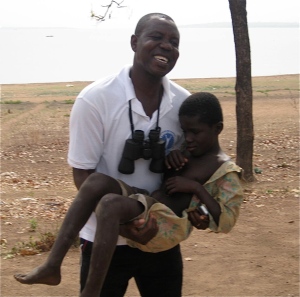 Many of you have asked, “How do you actually rescue a trafficked child from slavery?” In this post, I will do my best to explain the process. (Thank you, Liz, for your amazing editing.)
Many of you have asked, “How do you actually rescue a trafficked child from slavery?” In this post, I will do my best to explain the process. (Thank you, Liz, for your amazing editing.)
George Achibra founded PACODEP, a non-governmental organization based in the Volta Region of Ghana, which was initially focused on caring for orphans and widows. The issue of child trafficking and slavery became his passion after a former child slave, John, showed up at his door after running away from his fishing master. John had been beaten severely and was covered in bruises and blood. George cared for John and eventually found his mother and returned him to his family. A few months later, George learned that John was re-trafficked and sold again to another fishing master. After hearing this, George was determined to find John and rescue him again. He began renting a boat several times a week and scouring Lake Volta for this young child. During these visits, he saw hundreds of “Johns,” and was desperate to end this cycle that is ultimately rooted in poverty.
More than half of the people in Ghana live below the poverty line, so when parents hear of work opportunities on Lake Volta, they do not hesitate to send their children because it is one less mouth to feed. They often view it as an opportunity for their child to learn a skill and earn income, even if it means they miss out on their education. However, most parents do not know that their child is sleeping outside, working 12-16 hour days without pay, eating only one meal, and subjected to various types of abuses.
In order to search for these child slaves, George rents a boat on a weekly basis and journeys out onto Lake Volta. He stops when he sees a boat with children working and questions the fishing masters about the children. George asks common questions about their age and where they live, but mostly he is studying faces. It is often said that George Achibra never forgets a face.
George has several “informants” working for him on the islands. These informants are generally community leaders that know all of the masters and the trafficked children. The informant will give George the necessary information to find the child’s parents, usually within days.
When George finds the family, he explains the abusive conditions on Lake Volta and that their children are in fact not being paid. He talks with them about the importance of sending their child to school so they can provide for their families in the future. In many cases, the families are too poor to adequately provide for their rescued child, so George explains that as an alternative option he can sponsor the child to give them shelter, send them to school and provide them with health care. Then, the parents sign formal documents stating that they want their children to leave the lake and reside under George’s care.
George then returns to the lake with this documentation to find the child. Sometimes his search can take six months or longer because the fishing master has fled to another area of the lake. Other times, the child is easily located and George explains the law, presents the signed documents and asks the fishing master to release the child. Generally, the masters will release them, but if they are resistant, George can threaten arrest. So far, George’s rescue process has been successful and he has been able to save every child he has pursued. These children are sponsored by Touch a Life and reside near George’s home in Kete Krachi.
Please feel free to leave questions, comments or feedback. More information on George’s work and Touch a Life can be found at: http://www.touchalifekids.org.